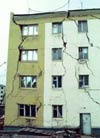



Many coastal communities and facilities face increasing exposure to storms.
Rising temperatures are already changing the Arctic coastline and more drastic changes are expected over the coming century. Reduced sea ice allows stronger waves to form, increasing shore erosion. This problem will be worsened by thawing permafrost and rising sea levels. All around the world, higher sea levels are likely to cause flooding of marshes and coastal plains, accelerate beach erosion, and force salt water into bays, rivers, and groundwater.
As warming begins to take its toll on Arctic coastlines, some towns and industrial facilities are already suffering severe damage and facing relocation.
Reduced sea ice is very likely to increase marine transport and access to resources.
Over the past 50 years, the area of Arctic sea-ice has declined and more recently the ice thickness has decreased by 10 to 15%. Observed trends enable the opening of new shipping routes around the margins of the Arctic Basin and a longer period during which shipping is feasible (when the extent of sea ice in a given location is less than 50%). This could have significantly facilitate transportation and access to natural resources. More...
6.2.1 The opening of historically closed passages raises questions regarding sovereignty over shipping routes and seabed resources, and regarding security and safety. Commercial fishing, hunting of marine wildlife by indigenous people, tourism and shipping all compete for use of the narrow straits of these waterways. Moreover, these are also the preferred routes for marine mammal migration.
Increased marine access has implications for national and regional governments which will be called upon for services such as icebreaking, ice charting and forecasting as well emergency preparedness. Ships themselves will have to be built to higher (and more expensive) standards to ensure safety in ice-laden waters. More...
6.2.2 However, recent changes suggest that actual conditions will in fact be harder to predict which will make planning for regular sea transport very difficult, and may restrict the use of the new shipping routes. The amount of sea ice and icebergs drifting into the Northwest Passage is limited by “ice bridges” that block northern channels and straits of the Canadian Arctic Archipelago. As warming causes the melting and weakening of these ‘ice bridges’ more ice and icebergs could drift into the transport routes of the Northwest Passage, presenting additional hazards to navigation. More...
6.2.3 Increased access to shipping routes and resources entails an increased risk of environmental degradation caused by these activities. A recent study suggests that oil spills and other industrial accidents could have serious, long-lasting effects in a high-latitude, cold ocean environment.
In 1989, the Exxon Valdez oil tanker slammed into a reef while maneuvering to avoid ice in the shipping lanes and poured 42 million liters (11 million gallons) of crude oil into Alaska's Prince William Sound. The spill was the worst tanker disaster ever in U.S. waters, killing at least 250 000 seabirds and thousands of marine mammals. It forced the closure of commercial fishing grounds and areas traditionally used to gather wild foods. Though some scientists’ predicted a rapid environmental recovery, small patches of oil remain and continue to cause problems for fish, seabirds, and marine mammals.
Despite preventive measures such as improved boat-building standards, and better port facilities and operating procedures, oil spills are still anticipated. Spill response operations are more complex and demanding in ice-covered waters, and effective response strategies have yet to be developed. More...
Thawing ground will disrupt transportation, buildings and other infrastructure More...
6.3.1 Arctic land is generally more accessible in winter, when the tundra is frozen and ice roads and bridges are available. In summer, when the top layer of permafrost thaws and the terrain is boggy, the transport of food and other raw materials over land can be difficult. Land transportation routes are thus likely to be affected by changing climate. Increased precipitation can cause landslides and rising temperatures can shorten the season during which ice roads can be used.
Travel on the Alaskan tundra is now only possible during 100 days per year compared to over 200 days thirty years ago. This results in a 50% reduction in the time period where oil and gas exploration and extraction equipment can be used. The timber industry also depends on frozen ground and rivers and transporting wood is increasingly difficult. More...
6.3.2 Increasing temperatures pose significant engineering challenges to infrastructure built on permafrost, such as buildings and industrial facilities. As a result of changing soil temperatures and more extensive melting and refreezing, new construction will require deeper foundations and thicker insulation, which entail greater costs.
In northern Russia, damage to railway lines, airport runways, and oil and gas pipelines due to thawing permafrost is now more frequent. Future thawing might weaken open pit mine walls, and lead to the release of contaminants from mine tailing disposal facilities into the groundwater.

Complete thawing of permafrost, which would eventually make the construction environment more predictable, is expected to take centuries.
Important and complex interactions exist between climate induced changes in permafrost and in ecosystems.

This summary is free and ad-free, as is all of our content. You can help us remain free and independant as well as to develop new ways to communicate science by becoming a Patron!